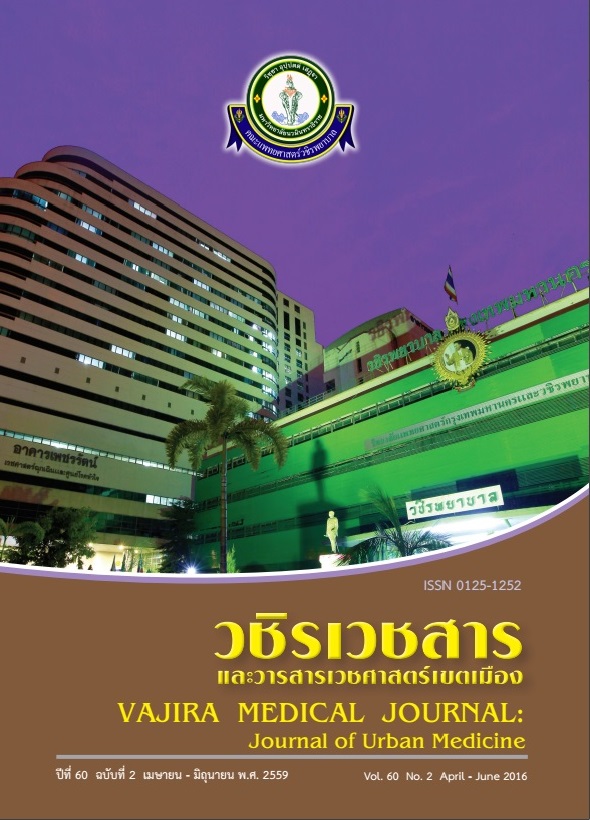The Effectiveness of intranasal Saline Irrigation compared with non-irrigation on Sinonasal Symptoms in acute bacterial rhinosinusitis (ABRS) of adult patientin Department of Otolaryngology Head and Neck Surgery of Faculty of Medicine Vajira Hospital, Navamindradhiraj University
Main Article Content
Abstract
Objective: To compare the effectiveness of intranasal Saline Irrigation with non-irrigation on Sinonasal Symptoms in acute bacterial rhinosinusitis of adult patient and search for the additional method that alleviate symptoms and improve quality of life of adult patient with Acute bacterial rhinosinusitis.
Method: This study is a prospective randomized-controlled trial study.Patients who met the inclusion criteria were devided into 2 groups by random number program. The group A were received nasal saline irrigation and group B did not receive nasal irrigation. Both group received same treatment including oral antibiotics (amoxycillin-clavulanate) and pain control. All participants were requested to record symptoms with Visual analogue score (VAS 0-10) and Sinonasal outcome test (SNOT-20) at the first visit and were followed up at 1,2 and 4 weeks after the first visit.
Result: We included 54 participants with acute bacterial rhinosinusitis. 28 of 54 participants underwent normal saline nasal irrigation. 26 of 54 participants did not receive nasal irrigation. Both groups had significantly improved mean Visual analogue score in all symptoms and Sinosasal outcome test at 1st, 2nd and 3rd weeks after followed up compared with the first visit. But there were not statistically significant difference of VAS and SNOT between both groups after followed up at 1st, 2nd and 3rd weeks.
Conclusion: The Effectiveness of intranasal Saline Irrigation were not statistically different compared with non-irrigation on Sinonasal Symptoms for treatment of acute bacterial rhinosinusitis (ABRS) in adult patients in Department of Otolaryngology Head and Neck Surgery of Faculty of Medicine Vajira Hospital, Navamindradhiraj University
Downloads
Article Details
References
2. Clinical Practice Guideline (Update): Adult Sinusitis; American Academy of Otolaryngology- Head and Neck Surgery Foundation 2015.
3. สุภาวดี ประคุณหังสิต. การอักเสบเฉียบพลันของโพรงอากาศข้างจมูก. สุภาวดี ประคุณหังสิต, บุญชู กุลประดิษฐารมณ์, บรรณาธิการ. ตำราโสต นาสิก ลาริงซ์วิทยา พ.ศ. 2537; 17:211-21.
4. Treebupachatsakul P, Tiengrim S, Thamlikitkul V.Upper respiratory tract infection in Thai adults: prevalence and prediction of bacterial causes, and effectiveness of using clinical practice guidelines. J Med Assoc Thai. 2006 Aug; 89(8):1178-86.
5. Tomooka LT, Murphy C, Davidson TM. Clinical Study and Literature Review of nasal irrigation. Laryngoscope. 2000; 110: 1189-93.
6. ฉวีวรรณ บุนนาค, ชลีรัตน์ ดิเรกวัฒนชัย, จรุงจิตร์ งามไพบูลย์, สงวนศักดิ์ ธนาวิรัตนานิจ, จามรี ธีรตกุลพิศาล, ประยุทธ ตันสุริยวงษ์. Clinical Practice Guideline on the management of Acute bacterial Rhinosinusitis. กรุงเทพฯ: ราชวิทยาลัยโสต ศอ นาสิก แพทย์แห่งประเทศไทย ราชวิทยาลัยกุมารแพทย์แห่งประเทศไทย สมาคมโรคภูมิแพ้และอิมมูโนวิทยาแห่งประเทศไทย สมาคมโรคติดเชื้อแห่งประเทศไทย และสมาคมแพทย์โรคจมูก. 30 หน้า.
7. Payne SC, Benninger MS. Staphylococcus aureus is a major pathogen in acute bacterial rhinosinusitis: a meta-analysis. Clin Infect Dis. 2007 Nov 15; 45(10): e121-7.
8. Heikkinen T, Jarvinen A. The common cold. Lancet. 2003 Jan 4;361(9351):51-9.
9. Kassel JC, King D, Spurling GK. Saline nasal irrigation for acute upper respiratory tract infections. Cochrane Database Syst Rev. 2010 Mar 17;(3):CD006821
10. Axelsson A, Chidekel N, Grebelius N, Jensen C. Treatment of acute maxil-lary sinusitis: a comparison of four different methods. Acta Otolaryngol. 1970;70:71-6.
11. Wang YT, Yang CP, Ku MS, Sun HL, Lue KH. Efficacy of nasal irrigation in the treatment of acute sinusitis in children; Int J Pediatr Otorhinolaryngol. 2009;73:1696–701.
12. Rabago D, Zgierska A, Mundt M, et al. Efficacy of diary hypertonic saline nasal irrigation among patients with sinusitis: a randomized cotrolled trial. J Fam Pract. 2002;51:1409-55.
13. Inanli S, Ozturk O, Korkmaz M, et al. The effects of topical agents of fluticasone propionate, oxymetazoline, and 3% and 9% sodium chloride solutions on mucocialiary clearance in the therapy of acute bacterial rhonosinusitis in vivo. Laryngoscope. 2002;112:320-25.
14. Harvey R, Hannan SA, Badia L, Scadding G. Nasal saline irrigations for the symptoms of chronic rhinosinusitis. Cochrane Database Syst Rev. 2007 Jul 18;(3):CD006394.
15. Adam P, Stiffman M, Blake RL. A clinical trial of hypertonic saline nasal spray in subjects with the common cold or rhinosinusitis. Arch Fam Med. 1998;7(1): 39-43.
16. Bollag U, Albrecht E, Wingert W. Medicated versus a line nose drops in the management of upper respiratory infection. Helvetica Paediatrica Acta. 1984;39(4): 341-5.
17. Slapak I, Skoupá J, Strnad P, Horník P. Efficacy of isotonic nasal wash (sea water) in the treatment and prevention of rhinitis in children. Archives of Otolaryngology-Head and Neck Surgery 2008;134 (1): 67-74.


